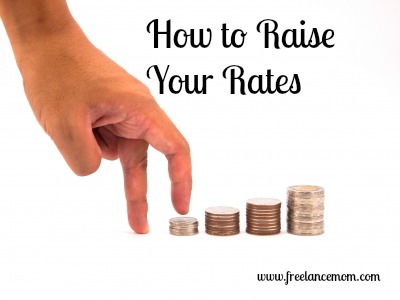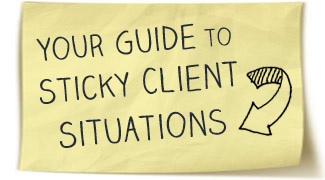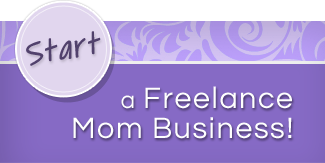
When was the last time you gave yourself a raise?
A friend of mine, who is a virtual assistant in Dallas, has told me that she would love to raise her rates from $30/an hour to $40 an hour and really feels like her work is worth that at this point. She has been a VA for over a year and feels the need to raise her prices but is scared and apprehensive, especially about losing her existing clients.
When you are self-employed and looking for clients (or reacting to ads for your services), it’s hard to think about proactively increasing your pay per hour or year in the same way you do when you work for someone else.
But you should be raising your rates every six months.
What is Your Real Hourly Rate?
Before you can raise your rates, you need to know what you are actually making per hour.
Your personal rate is a compilation of the rates paid to you by all of your clients. You probably have a few higher paying clients, some at the lower end, and a few stalwarts in the middle.
Let’s say that as a coach, you charge private clients $100 per hour. For group calls, which you sell as a package, each attendee pays about $30 per hour-long call, but you have ten people per group and spend an hour prepping for the call, so your hourly rate is $150. You also run four-week workshops that cost $249 per person, usually have 30 people, and take about ten hours of your time per week between setting up assignments, running calls, and responding to participant emails. That comes out to $186 per hour.
Maybe you’ve got 10 private clients per month, three weekly group calls, and one workshop. That’s 10 hours at $100 per hour, around 13 at $150 per hour, and 40 at $186 per hour, so you’re average rate is $165 per billed hour (we’re not counting the hours you spend on marketing, administration, and other non-billing activities here).
The Nitty Gritty of Raising Your Rates
$165/hour is a great rate. But how can you raise it?
Some very quick ways to raise your rates are:
- work faster (if you do a type of work that prices per project, like creative work)
- outsource parts of your work that you do slower to a contractor who works at a lower rate than you do
- say no to or stop working with lower-paying clients to bring up your average
- ring in more higher-paying clients
But the easiest way to raise your rates is to get more money from the clients you already have. Client acquisition is a time-expensive process. (If you don’t feel comfortable raising your rates with current clients because you are already charging a high price, then look at the options above again to see other ways you can raise your rate).
November through February are the perfect time to raise rates with the clients you already have because that is when companies discuss raises for their own employees. It’s a natural opener and frames the discussion in a way that shouldn’t take your clients by surprise or put too much onus on you to justify the jump.
Keep the conversation presumptive—you show that you assume it is natural to raise your rates this time of year, and the client will presume that they should have known this and have a harder time saying no:
Dear client,
Happy Thanksgiving/Holidays/Happy New Year/Good Afternoon (whatever opener you want to use)
I’m just writing to let you know that I have really enjoyed working with you this past year. I know that my work on _____________ (something you have done for the client) has helped you __________________ (some feedback you’ve gotten from the client or results), and I’m so glad I could help you meet your goals.
At the beginning of the new year, I’m going to be raising my rates, and I wanted to give you a heads up about the change. As I have grown over this year, particularly in terms of ______ (skills that you have gained this year, particularly experience with software or ___ the client uses), my rates will be adjusted accordingly.
Currently, I’m doing ______ (project/service) for you at $## per hour/project. Beginning January 1st, the rate for that will be $##.
If this is an issue with your budget, please let me know and we will discuss other options.
I look forward to continuing our fruitful collaboration!
Best,
You
What Clients Might Counter and How You Should Respond
Unless you ask for a huge bump, you should be shocked at how many of your clients say okay and thank you for all the great work you’ve done for them.
In many cases, clients will object that they simply don’t have the budget for what you’re asking for. “That’s no problem,” you’ll say. But you need to be firm. Don’t keep doing the same work for the same rate.
Ask how you can change what you provide to the client so that you are getting a bump in your hourly rate even if they are paying you for essentially the same thing:
- if you’re a coach, offer to do 45 minutes at the previous rate instead of an hour
- if you have a regular creative client, try to substitute shorter (300-word blog posts instead of 500-word posts) or fewer deliverables for the same rate
- if your work involves project management, suggest that the client take on some of those responsibilities
Some clients won’t be able to give you the rate you’ve asked, but they’ll give you a smaller bump. That’s great! You should quote a higher rate than you expect in your initial ask and plan for this to happen.
In some rare cases, a client will not be 100% happy with your services, and they’ll use this as an opportunity to terminate your collaboration. If they want to leave, don’t try to stop them.
You’re better off replacing them with a happier, high-paying client. Which brings me to…
How High Can You Go?
I recently read an inspiring article about how someone bought an apartment exclusively to rent it out on AirBnB.com and made 13,608 in his first year. Interestingly, when he first listed his rental, he priced it significantly lower than his target rate because he knew that multiple positive reviews are a key to success at competitive rates.
Many new self-employed women do the same thing. It’s natural when you don’t have a lot of clients or testimonials to feel like you need to give prospects a discount to encourage them to take a risk trying something new and unproven.
The key is to get away from those rates as soon as you can.
Depending on how confident you are in yourself and how in-demand your abilities are, you can bring your hourly rate from $20 to $200 in one go, like many content producers who have gotten away from third-party sites like Demand Studios, Elance, and Craigslist and found direct clients.
You can almost never make a jump this huge with clients who are paying your bottom rates.
Pretend you are the hypothetical coach we walked through earlier. If you signed more people up for your workshops, you’d need to put more time into marketing and more time into customer service for the new participants, so that wouldn’t result in much of a bump in your rates. If you raised your rates with private clients from $100 to $300 per hour, you would certainly lose some.
The only way to quickly and reliably give yourself a big jump in pay is through different, higher paying work.
Once you discuss raising your rates with current clients and shed some clients who aren’t able to pay the rates that you deserve in the coming year, bring your hourly rate up significantly higher in one swoop by putting your new free time into bringing in bigger clients or projects.
Photo Credit: Freedigitalphotos.net





